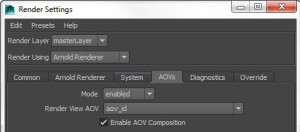New with Arnold 6.0.4 is path mapping.
All you have to do is create a json file that looks something like this:
{
"windows": { "S:/": "\\server\projects\" },
"mac": { "S:/": "/Volumes/projects/"},
"linux": {"S:/": "/mnt/projects/"}
}
and then set ARNOLD_PATHMAP to point to the json path mapping file
How Arnold handles paths
When you render a frame, here’s what Arnold does for file paths:
- Replace backslashes
When Arnold loads an ass file, Arnold replaces all backslashes ( \ ) with forward slashes ( / )
- Expand environment variables
When Arnold uses a parameter, Arnold expands all environment variable references, which look like this:
[MY_TEXTURE_PATH] - Map paths
After Arnold expands environment variables, Arnold applies the path-mapping rules specified by the Arnold pathmap file.
Arnold expands environment variable expansion and maps paths for:
- search paths in the options node
- filename parameters for these nodes:
- alembic
- color_manager
- all driver nodes such as driver_deepexr, driver_exr, driver_jpg, driver_png, and driver_tiff
- image
- include_graph
- materialx
- photometric_light
- procedural
- volume
- volume_implicit
Setting up path mapping
You can automatically remap paths at render time using a pathmap file.
To use a pathmap
- Set the
ARNOLD_PATHMAPenvironment variable to point a pathmap file
The pathmap file is a json file. For example:
{
"windows": { "S:/": "\\server\projects\" },
"mac": { "S:/": "/Volumes/projects/"},
"linux": {"S:/": "/mnt/projects/"}
}
Path mapping uses regular expressions. The general format of an entry is this:
{
"windows": { "regular expression": "replacement string" },
}
For example, this pathmap replaces all drive mappings like E:/ and S:/ with //SERVER/
{
"windows": { "[A-Z]:/": "//SERVER/" },
}
Arnold converts backslashes ( \ ) to forward slashes ( / ) when it loads the ASS file.
Path mapping happens after that, so pathmaps never have to deal with backslashes.
There can be multiple mappings for each OS:
{
"windows": { "[A-Z]:": "//SERVER", "sourceimages/": "textures/"},
}








